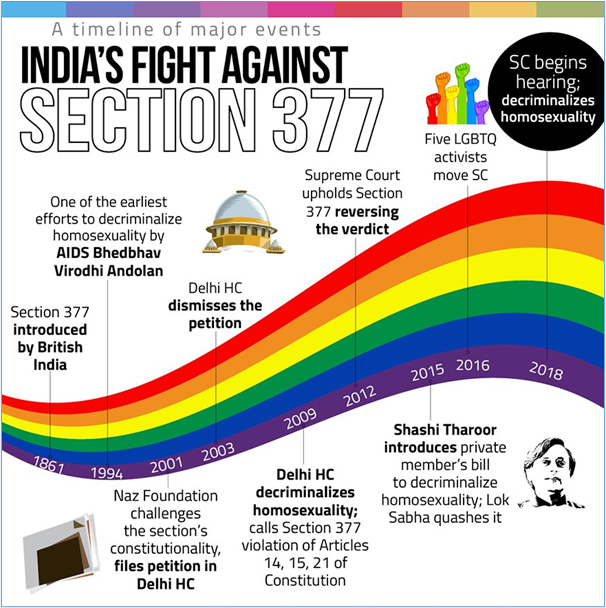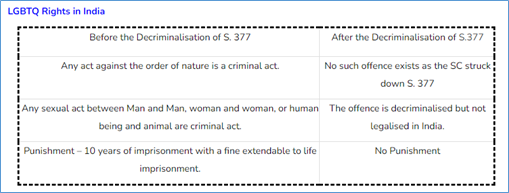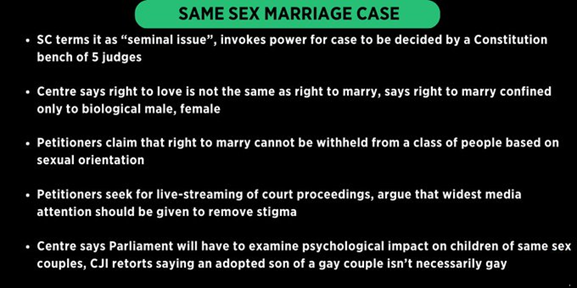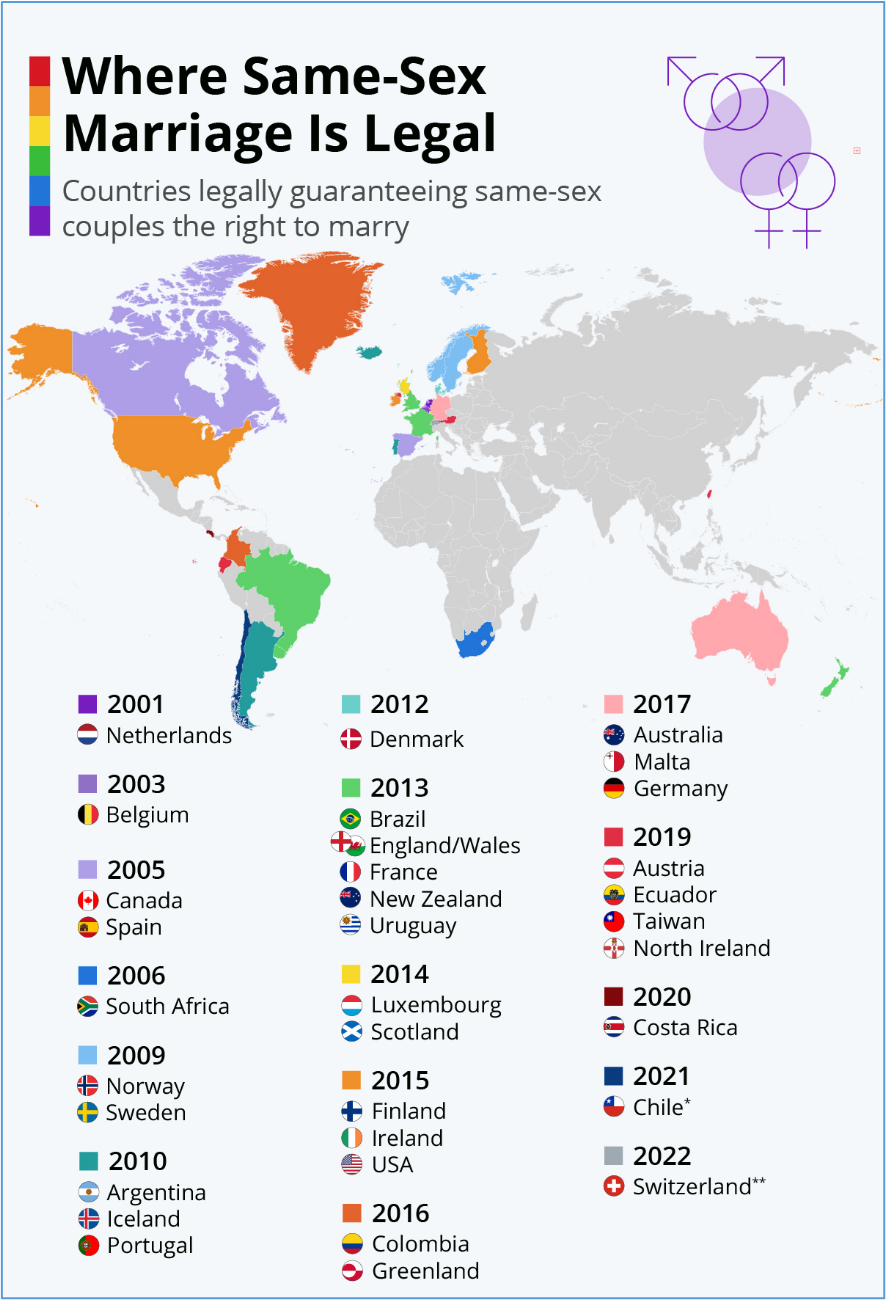PREVIOUS
Same-sex marriage
April 21 , 2023
1000 days
3724
0
(இதன் தமிழ் வடிவத்திற்கு இங்கே சொடுக்கவும்)
- Same-sex marriage is marriage between partners of the same sex and/or gender identity.
- For example, a marriage between two men or two women.
Constitution provisions
- The right to marry is a part of the right to life under Article 21 of the Constitution of India, 1950.
- This was also established in the landmark case of Lata Singh v. State of Uttar Pradesh (2006) where the Supreme Court of India upheld the right of an individual to marry any person of their choice and recognized the same as a fundamental right.
- In India, same-sex relations were not recognised up until 2018 recently, when Article 377 was read down by the Supreme Court of India in Navtej Johar v. Union of India (2018), after which homosexuality has been decriminalised.

- But still, the marital union between same-sex couples is not recognised by law in India and consequently, they are not entitled to any spousal privileges, those being adoption rights, inheritance rights, etc.
- Even in the Navtej Johar judgement, though the judges discuss various foreign cases which have legalized same-sex unions in other countries at length, they refrained from making any comments about whether such unions need to be given marriage or civil union rights in India or not.
- Merely decriminalizing sexual intimacy between same-sex couples would not place them at an equal footing with heterosexual couples.
- This can only be done by affirmative action in their favour, otherwise, they would be subject to the same unequal and discriminatory behaviour for years to come.
- Same-sex relations are still seen with the lens of shame in India, and this has a lot to do with the obsession over marriage which is seen as a necessity.
- Along with marriage (heterosexual) also comes various rights which unmarried couples (except those in long term live-in relationships) do not have.

Same-sex Live in Relationships in India
- In the case of S.P.S. Balasubramanyam v. Suruttayan (1994), the Supreme Court ruled that a man and a woman living together under one roof for a couple of years will be presumed to be husband and wife.
- In case of Indra Sarma v. V.K.V. Sarma (2013), the Supreme Court held that a woman who begins to live with a man not knowing that he is already married would still be considered as a “domestic relationship” under the Domestic Violence Act, 2005.
- In September 2020, the Orissa High Court in the case of Chinmayee Jena v. State of Orissa (2020), upheld the right of a transgender man to be in a live-in relationship with his same-sex partner and self-determination of sex/gender.
- In another case of Madhubala v. State of Uttar Pradesh (2020), the Uttarakhand HC held that same-sex couples have a right to live together, and such a consensual relationship where such couples are co-habiting cannot be held to be illegal, because right to determination and choice of sexual orientation in partner is a fundamental right under Article 21.
- But the court went on to mention that in India, still, the LGBTQ+ individuals cannot enter into a wedlock, hence reiterated the fact that same-sex couples still do not have the rights given to heterosexual couples post marriage.
Heteronormative Marriage Laws
- Due to the religious and cultural diversity in India, people are free to choose the religious law under which they want to get married.
- Some of these laws include the Hindu Marriage Act, 1955, Muslim Personal Law (Shariat) Application Act, 1937, Indian Christian Marriage Act, 1872, Special Marriage Act, 1954 etc.
- These laws have been applied as well as legally interpreted in a heteronormative manner till date, having no space for same-sex relationships.
Hindu Marriage Act, 1955
- The preamble of the Hindu Marriage Act, 1955 explicitly states that the Act applies to “any two Hindus” and does not say that one of them should be a man and the other should be a woman.
- However, if we look at Section 5 of the same law, it states words like “bride” and “bridegroom” which points out to the presumption of heteronormativity of relationships while drafting the law.
Indian Christian Marriage Act, 1872
- Under Christian law, there is a heterosexual notion to marriage despite a lack of any explicit definition of marriage stated anywhere in the law.
- However, for example, if we look at Section 60, it states that the age of man should be 21 and the age of the woman should be 18.
- Drafting of such provisions in the law indicates the heterosexual notion intended for this law.
Muslim Personal Law (Shariat) Application Act, 1937
- In Muslim law too, though marriage is governed by their personal laws, it is seen as a civil contract.
- Since the purpose of the civil contract is procreation, this again presumes the heterosexual nature of Muslim marriages.
Special Marriage Act, 1954
- If we take a look at the Special Marriage Act, which is open to all religions and is a secular law, there are certain heterosexual underpinnings to it.
- For example, when it defines what prohibited relationships are, it uses words like man and woman.
Choosing a person for marriage: A Fundamental Right
- In case of Shakti Vahini v. Union of India (2018), Shakti Vahini, which is an NGO, filed a petition in the Supreme Court to take preventive actions against honour crimes.
- In another case of Shafin Jahan v. K.M. Ashokan & Ors. (2018), which was relied on by the Navtej Johar judgement, it recognises the right of a Hindu woman to freely convert to Islam and marry a Muslim man.
- The Supreme Court held that it is the constitutional right of a citizen of India “to be able to live her life on her own terms” and that “curtailment of the expression of choice of an individual will destroy the individualistic entity of a person”.
- If we read the cases of Shakti Vahini, Shafin Jahan and Navtej Johar together, we can effectively come to the conclusion that there is room to argue for same-sex marriages in India through a combined reading of these cases.
- Although in the case of Navtej Johar, the judges did not delve into any discussions on the topic of same sex marriages, but they did recognise the LGBTQ+ community as a sexual minority which has borne the brunt of hostile discrimination without any justification. Article 15 of the Constitution of India, 1950 prohibits discrimination on certain grounds alone.
- In the Navtej Johar case, Justice Indu Malhotra said that Article 15 should be extended to include the ground of sexual orientation, so that discrimination on the grounds of sexual orientation alone should mean that the Article is being violated, which in turn would violate a person’s fundamental rights.
Recent Case on Same Sex Marriage
- A Bench led by Chief Justice of India refers petitions to legally recognise same-sex marriages to a Constitution Bench of five judges of the Supreme Court recently.
- The Bench comprises Chief Justice of India D Y Chandrachud, Justices Sanjay Kishan Kaul, Ravindra Bhat, Hima Kohli, and P S Narasimha. Justice Chandrachud was also a member of the constitution bench, which, decriminalised sex between two gay, consenting adults by way of the 2018 Navtej Singh Johar judgment.
- “We are persons who are of the same sex. We have, account to us, the same rights under constitution as heterosexual group of society. Your lordships have held that. The only stumbling block on our equal rights was 377. Criminality is now gone. The unnatural part or order of nature is gone from our statute. So therefore our rights are equal."
- “If our rights are identical as held by the State, then we want to enjoy the full extent of our rights under 14,15,19, and 21.”
- “Concept of marriage has changed over last 100 years. Earlier we had child marriages, temporary marriages, a person could marry any number of times - that also changed.
Stand of Government Regarding Same Sex Marriage

- The Centre has opposed same-sex marriage in the Supreme Court, stating that marriage between a biological man and woman is a holy union, a sacrament, and a sanskar in India.
- The government argued that the Court had only decriminalised sexual intercourse between same-sex persons in its 2018 judgement in Navtej Singh Johar v. Union of India, and not legitimised this “conduct”.
- The court, while decriminalising homosexuality, did not accept same-sex marriage as part of the fundamental right to life and dignity under Article 21 of the Constitution.
- The government argues that marriage depends on customs, rituals, practices, cultural ethos, and societal values.
- Same-sex marriage cannot be compared to a man and woman living as a family with children born out of the union.
- The Parliament has designed and framed the marriage laws in the country to recognise only the union of a man and a woman.
- Registration of marriage of same-sex persons would result in a violation of existing personal as well as codified law provisions.
- The Special Marriage Act of 1954 provides a civil form of marriage for couples who cannot marry under their personal law.
- The government argued that any deviation from this norm can only be made through the legislature, and not the Supreme Court.
Arugments in Favour of Same Sex Marriage
- Equal Rights and Protection Under the Law: All individuals, regardless of their sexual orientation, have the right to marry and form a family.
- Same-sex couples should have the same legal rights and protections as opposite-sex couples.
- Non-recognition of same-sex marriage amounted to discrimination that struck at the root of the dignity and self-fulfilment of LBTQIA+ couples.
- Strengthening Families and Communities: Marriage provides social and economic benefits to couples and their families. Allowing same-sex couples to marry strengthens families and communities by promoting stability and security.
- Global Acceptance: Same-sex marriage is legal in many countries around the world, and denying this right to individuals in a democratic society goes against the global principles.
- In 133 countries homosexuality decriminalised, but only in 32 of them same-sex marriage is legal. Countries legalised same sex marriage.

- Even though the Constitution of India enshrines us with the freedom of self-determination and the choice of a life-partner, India’s attitude towards same-sex marriages is still restrictive.
- The laws either have an explicit heterosexual underpinning to them, or, generic provisions have been interpreted to cater to heteronormativity.
- A relative change in the attitude of the judiciary has been observed with respect to making space for the LGBTQ+ community to exercise their rights and to be able to live with a partner of their choice. However, still, we are much away from handing them equal rights afforded to heterosexual couples.
- - - - - - - - - - - - - -
Leave a Reply
Your Comment is awaiting moderation.


